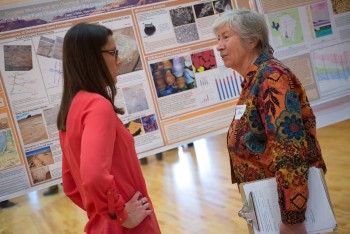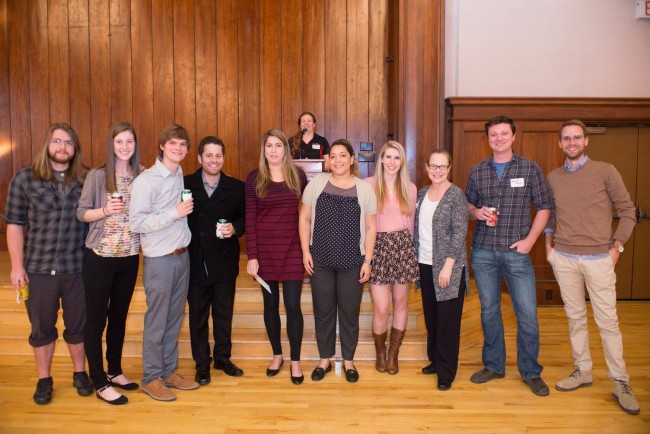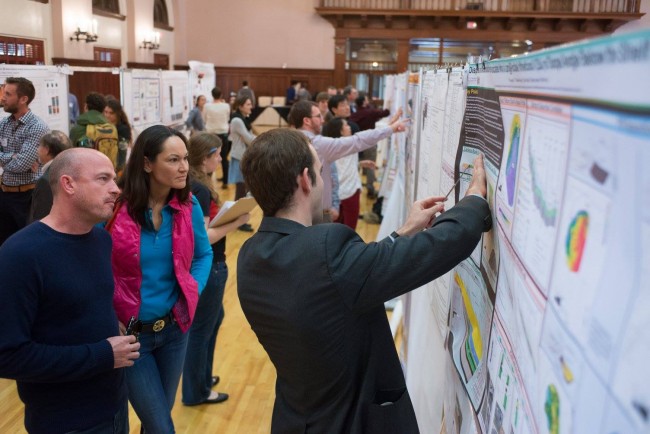Honing in on Science at the 5th Annual Student Research Symposium
February 10, 2016
A crucial skill for scientists is the ability to communicate their work to others. Conversations can turn into collaborations, questions can lead to surprising answers, and criticism can sharpen research.
This talent was on display at the 5th Annual Jackson School Student Research Symposium on Feb. 6, 2016. The event brought more than 130 students together from across the Jackson School of Geosciences to hone their skills and present world-class science in all six of the school’s research themes: climate, carbon and geobiology; energy geosciences; marine geosciences; planetary sciences; solid earth and tectonic processes; and surface and hydrologic processes.
“I think this is really great for all of us because we get to see the diversity of Jackson School science, which I think is unique to us as a program,” said Whitney Behr, an assistant professor in the Department of Geological Sciences whose research team won the award for best represented group.
The event, organized by the Graduate Student Executive Committee and sponsored by ConocoPhillips, is patterned after

an AGU-style poster competition. Faculty, research scientists and alumni served as judges.
The tremendous diversity of the science taught at the school makes the symposium a unique and challenging setting, said second-year master’s student Luciana De La Rocha, particularly when students have to explain their work to someone outside their field. De La Rocha presented research on siliciclastic sedimentation in the Gulf of Mexico.
“It makes you think about the details and the simplest way to explain a project,” she said. “But the feedback was great. There was lots of constructive criticism.”
Mason Phillips, a first-year master’s student, agreed. Phillips was showcasing his research on an algorithm that can automate fault detection in seismic images. He said the experience was tremendously valuable – but a little daunting.
“It’s very intense, especially being an exploration geophysicist and seismologist talking to geoscientists in other fields,” Phillips said. “Seismologists can get tucked away in a corner and don’t always get to communicate their research with other geoscientists.”
Andrea Nolting, a third year Ph.D. student, has been through many poster presentations, at the Jackson School and at outside scientific conferences. She said the symposium was a great environment for students with less experience to cut their teeth in front of a home crowd.
That was the experience for Natalie Raia, a fourth-year undergraduate who won second place among undergraduates for her research on the tectonic history preserved in metamorphic rocks in Syros, Greece.
“As an undergraduate, the symposium gives me a safe and welcoming platform to present research,” Raia said. “In having to explain concepts, answer questions, and respond to feedback, I am made aware of gaps in my knowledge, potential challenges to interpretations, and possible new directions to add in the future.”
The overall impression of the judges?
“The depth and breadth of the work is amazing,” said Jackson School Dean Sharon Mosher. “Several of our alumni judges commented that they are glad not to be back in school competing with the students who showcased their work.”
The winners are as follows:
Early Career Grad
1st place: Sarah George, “Basin evolution in northern Peru: Implications for the growth of topographic barriers linking the Central and Northern Andes”
2nd place: Tomas Capaldi, “U-Pb geochronology of modern river sands from wedge-top foreland depo-centers; when sinks becomes the source”
Late Career Masters
1st place: Kelly Regimbal, “Optimizing CMP Stacking Using the Seislet Transform”
2nd place: Matt Ledvina, “Investigating the Pathways and P-T-X Conditions of Hydrothermal Fluid Flow Responsible for Cu-Au Mineralization in the Ertsberg East Skarn System, Papua, Indonesia”
Late Career PhD
1st place: Mason Fried, “Mass Loss Down Under: Distributed Subglacial Discharge Drives Significant Submarine Melt at a Tidewater Glacier”
2nd place: Romy Hanna, “3D measurement of fine-grained rims in CM Murchison using XCT”

Undergrad
1st place: Susannah Morey, “The Evolution of the Surveyor Fan and Channel System, Gulf of Alaska Based on Core-Log-Seismic Integration at IODP Site U1417”
2nd place: Natalie Raia, “Petrogenesis of Cycladic Serpentinites: Understanding the Tectonic History Preserved in Metamorphic Rocks in Syros, Greece”
Best Represented Group
1st place: Whitney Behr
2nd place: Sergey Fomel

